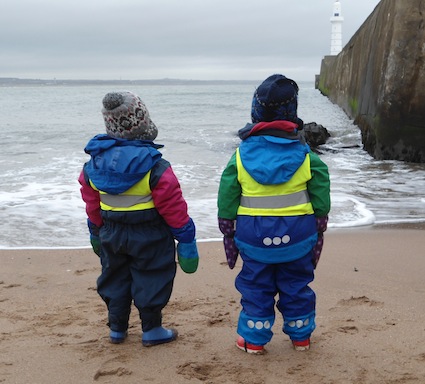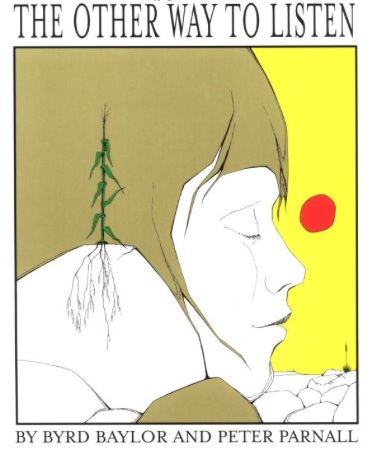I have noticed that if children of all ages are given enough time to freely play in a natural setting, then at some point, they will sit or stand and just be for a while. They seem to tune into the environment, the sights, sounds, smells and feelings. I tend not to see this as much in busy school grounds and nursery settings.

I’m not sure why this is – whether it’s being given sufficient time simply to “be” outside, or whether it’s because there are less people and artificial interruptions or perhaps it is something to do with the space and freedom of afforded by a wilder, more natural space. However it is wonderful to see and to witness the sense of calm that falls over a group or individual child.
So here’s some other suggestions to help children to tune in to their surroundings and make the most of those moments of simply “being” – it would be lovely if you were willing to add your own ideas to the list too. I’m aware that meditation and mindfulness are now commonly undertaken with children and perhaps these suggestions with dovetail with other ideas.

1) Read The Other Way to Listen by Byrd Baylor
This book is not about listening to audible sounds such as songbirds or waves. It considers sounds such as rocks murmuring and hills singing. It suggests that active listening takes a lot of practice and can be hard to achieve. It is important not to hurry the process.
Although the illustrations are definitely on the alternative side, I am constantly amazed at how children listen to this book and buy into the message. It helps them think about listening and being in nature in a different way.
2) Make time to relax
Make sure you are alone or with a friend who knows how to be quiet. Find a really calm place outside. Think about whether it is:
- a nook or cranny you can hide in
- a bush to crawl under
- a tree to climb into and become part of
- a view from a hill or elevated space
- a place where you can just watch the world go by
- a space where you can comfortably lie down
Think about what you can see, hear, smell and feel. If it helps, close your eyes. With the feelings, notice where they are in your body. Do they move through your body in a particular direction or at a specific speed? Is there a change in your body temperature when this happens?
This activity raises the question about our school grounds and outdoor spaces. They have to accommodate many children and finding time and space to be alone can be hard. It may be worth asking your children for suggestions here about where they can go. If space and time are limited then in what ways can this be changed?
3) Watch the world go by
Find a place to sit with a view. Sit there for several minutes just watching the world go by. Think about what you find particularly fascinating. Is it clouds racing by? Is it birds flying about? What about the wind moving through the trees. Is it the sights smells or sounds which hook you in the most?
4) Go wave watching
This can be a very relaxing experience. Find a good place to sit and enjoy the rhythm and patterns of waves. Look for the white horses on a windy day. These are white tips on top of the waves.
5) Gaze into a fire
There is something rather hypnotic about a fire. It is also a place where people come together. Yet for many children, just staring into the fire is a state of being that is hard to gain elsewhere. When did your class last have this chance?
6) Find another place
At Crosby Beach, Antony Gormley’s sculpture Another Place can be seen along a two-mile stretch of the sands. About 100 cast-iron replicas of the artist’s body have been sited here. They all face out to see but some are sunk deeper into the sand and some are closer to the sea. This variation adds interest to the beach walk. What I like are the questions that spring to mind when you see this sculpture. It can be fun to simply stand beside one of the figures and look out to sea. What you are seeing is what the sculptures will see. It’s a chance for children to stop, look and just be.
Get children to have a look at the online images of Another Place. Where is the best view outdoors – both in the schools grounds and locally? If you were a statue, where would you want to be sited?
7) Dizzy with excitement
Spin round and round on a soft surface such as grass. Do this until you are so dizzy you have to stop. Is this the same feeling as being dizzy with excitement? Write down your thoughts and feelings so that you can compare when an exciting moment happens.
8) Get a feeling for your school grounds
Memories can also be inextricably linked to places and how you feel about them. Brainstorm 10 different feelings you know. Then go out into your grounds and map these feelings according to different places that exist. For example, you might feel wonder in a natural space, annoyed about where you line up, happiness at the school gate. Are there any places which enable contrasting feelings to be experienced? For example on the football pitch, you may feel excitement if your team is winning but despair if it is losing. Share your ideas with the rest of the class.
9) Decision stones
First of all find two stones which are distinctly different but feel quite right when you pick them up, hold them, smell them, and walk around with them in your pocket. These stones will help you make decisions. We have to be calm, clear our minds and listen to our “inner voice”. One is to be your “Yes” stone, the other “No.”
Think of a decision you need to make and turn it into a question where the answer is either “Yes” or “No.” Ask yourself the question and touch the stones. Intuitively one stone will feel more right than the other. After a few weeks, review the stones with your class. Has anyone used them and were they helpful?
10) Creative Walks
“If you are seeking creative ideas, go out walking. Angels whisper to a man when he goes for a walk.” – Raymond Inmon
There is something about going for a walk which clears one’s head and helps with the flow of ideas. Whether it’s the plodding, the moving or just the journey, it can make a difference.
Through the years, different types of walk have evolved for different purposes. Labyrinths and circumambulation walks are useful for reflection. Blindfold walks give us an new way of exploring the world. Slow walks where one takes ten minutes to move a few metres can help children become very aware of their own bodies.
This blog post was originally published in January 2014.




















Thanks Juliet – another great blog post.
Just to add that if folk go to the Thinking Child Facebook page there’s a competition to win a Starter for Thinking Outdoors pack, Just need to LIKE and SHARe the post to be in with a chance.
A bit like “dizzy with excitement”. Be blown about by the wind. Go to a really open field or hill and run/ spin/ rest/ jump in turn with the wind as it gusts/blows/rest. Imagine you are a leaf or a butterfly if it helps. Believe that it doesn’t matter what you look like. This usually results in a lot of laughter and release and a better sense of the space around you.
Follow an ant- I’ve done this on my patio with chalk. Be careful not to squash the ant with the chalk.
Lastly- I once had a Forest School session where a boy who suffered severely on the Autistic Spectrum simply sat and shredded rhododendron leaves in different patterns while looking and listening to his surroundings. His teachers noted that it was a complete change in his behaviour to sit still and calm for any length of time.
Thanks Helen – these are great ideas which really add to the post! Aaaah – the power of sharing!
This is such a wonderful post! It brought back memories of my sister and I laying in the front yard watching the clouds go by. Thanks for sharing these ideas.
I think by nature children are impatient as their first priority is to have fun exploring and playing. I just think it takes them a little time to pause and notice their surroundings. 10 great inspirational ideas to try, thanks for linking up and sharing with Country Kids.